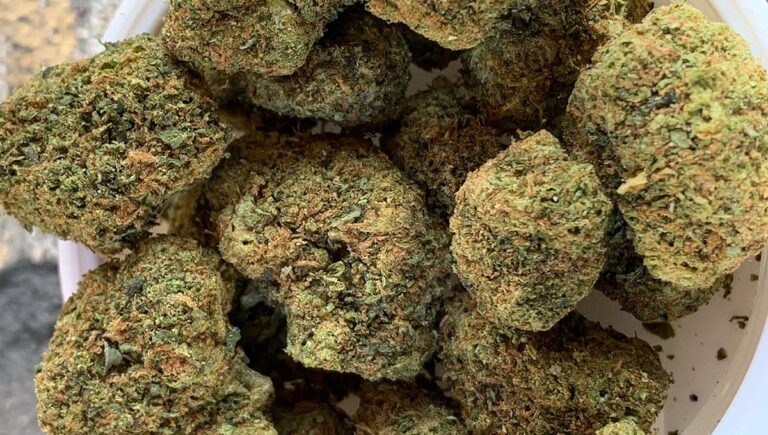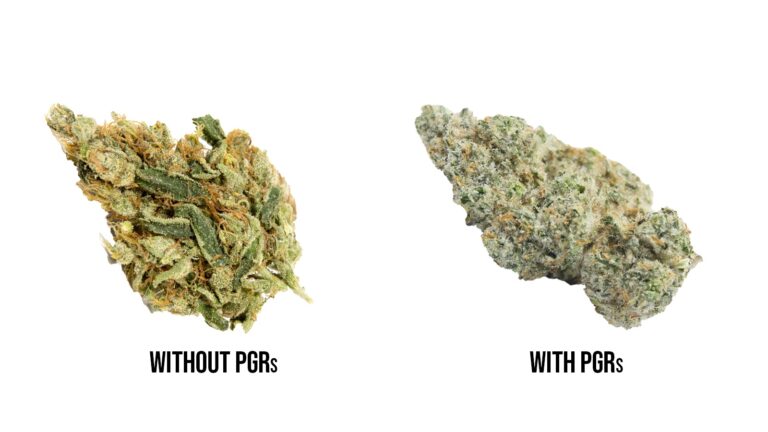PGR Weed Uncovered: What Cannabis Consumers Need to Know
Cannabis cultivation methods and terms are as diverse as they are intriguing. Among the various terms and jargon, PGR weed stands out as a topic of considerable discussion. PGR, or plant growth regulators, are substances used to control the growth and development of plants. However, there’s a stark difference between PGR weed vs natural weed that consumers should be aware of.
We are going to uncover the facts about PGR weed and arm you with the knowledge you need to make informed decisions. In the spirit of education and entertainment, we’ll dive into the science behind PGR weed, explore its impact on your cannabis, and debunk some common misconceptions. We’ll also share some fascinating facts about the cannabis industry and how PGR weed has made its mark.
What is PGR weed?
So, what is PGR weed? PGR weed refers to cannabis that has been treated with synthetic plant growth regulators to enhance its growth and appearance. These substances can significantly alter the plant’s natural growth patterns, leading to denser buds and a more ‘enhanced’ look. However, this comes at a cost, with PGR weed vs natural weed often showing several differences in quality, flavor, and potential safety.
The use of PGRs in cannabis cultivation is controversial, with critics arguing that it prioritizes aesthetics over quality and safety. Despite the initial appeal of PGR weed’s dense buds, true cannabis connoisseurs value the natural flavors and aromas that are often diminished in PGR-treated plants. Interestingly, the use of PGRs isn’t unique to cannabis. They’re also used in the cultivation of fruits, vegetables, and ornamental plants.

What Synthetics Are Used to Create PGR Weed?
Several synthetic plant growth regulators are used in creating PGR weed. Knowing how to tell if weed is synthetic can be challenging, but being aware of the common substances used, such as paclobutrazol, daminozide, and chlormequat chloride, can help. Each of these substances has a unique impact on the cannabis plant, affecting everything from its size and shape to the density of its buds.
The use of these synthetics is a testament to the lengths some growers will go to enhance their crop’s visual appeal, often at the expense of quality and safety. These substances are also used in other areas of agriculture, but the potential health risks associated with inhaling smoke from PGR-treated plants have led many to question their use in cannabis cultivation.
START SHOPPING NOW
Paclobutrazol
Paclobutrazol is a plant growth regulator often used in PGR weed production. This substance inhibits the plant’s growth, resulting in smaller, denser buds. While it may improve the visual appeal of the weed, plant growth regulators in weed, especially paclobutrazol, can potentially impact the overall quality and safety of the PGR weed.
Outside of cannabis, paclobutrazol is used in horticulture to control the size of ornamental plants. Its use in cannabis cultivation is a relatively recent development, driven by the desire for visually impressive buds. This desire for aesthetics can come at a cost, with paclobutrazol-treated plants often lacking the rich flavors and aromas of their naturally grown counterparts. There are concerns about the potential health risks of inhaling smoke from paclobutrazol-treated plants, with some studies suggesting it may be harmful.
Daminozide
Another common substance used is daminozide. Like paclobutrazol, daminozide affects the plant’s growth patterns, leading to denser buds. This substance has been linked to potential health risks, raising concerns about the use of such plant growth regulators in weed and their presence in PGR weed.
Originally developed as a pesticide, daminozide has found its way into cannabis cultivation due to its ability to control plant growth. However, its potential health risks have led many to question its use. Shockingly, daminozide has been banned for use on food crops in several countries due to these concerns. The fact that it’s still used in some cannabis cultivation highlights the need for consumers to be aware and make informed decisions about their cannabis consumption.
Chlormequat chloride
Chlormequat chloride is another one of the most common plant growth regulators in weed. It functions similarly to paclobutrazol and daminozide, affecting the plant’s growth and resulting in visually appealing but potentially lower-quality PGR weed. Despite its popularity among some cannabis growers, chlormequat chloride has been associated with potential health risks.
Its use in cannabis cultivation is a contentious issue, with critics arguing that it prioritizes aesthetics over consumer safety. Outside of cannabis, chlormequat chloride is also used in the production of ornamental plants and some fruits. However, the potential health risks associated with inhaling smoke from plants treated with this substance have led to calls for greater regulation of its use in cannabis cultivation.

PGR Weed vs Natural Weed
When comparing PGR weed vs natural weed, several differences become apparent when you look at how to tell if weed is synthetic. Natural weed tends to have a more robust flavor and aroma, thanks to its natural terpene profile. Although challenging, knowing how to identify PGR weed can be beneficial. PGR weed often appears unusually dense and compact, with a lack of visible trichomes that are typically present in high-quality, natural weed.
On a deeper level, the difference between PGR weed and natural weed comes down to the growing process. Natural weed is cultivated without PGRs, allowing the plant to grow and develop naturally. In contrast, PGR weed is often grown to maximize visual appeal, even if it means compromising on quality and potential safety. As a consumer, understanding these differences can help you tell PGR weed vs natural weed.
Is PGR Weed Safe to consume?
The safety of consuming PGR weed is a topic of debate. While plant growth regulators like paclobutrazol, daminozide, and chlormequat chloride can enhance the plant’s visual appeal, they may also pose potential health risks. Further research is needed to definitively assess the safety of consuming PGR weed.
It’s essential to remember that not all weed is created equal, and the use of PGRs can significantly impact the product’s quality and safety. Always prioritize products from reputable sources that prioritize quality and safety over aesthetics. If in doubt, consult with our knowledgeable staff or do your research to ensure you’re making a safe and informed choice.
Is PGR Weed Legal?
The legality of PGR weed varies by region. In some places, the use of certain plant growth regulators is banned due to potential health risks, while in others, it may be legal. Knowing what is PGR weed and how to identify PGR weed can help you make informed decisions about your cannabis consumption.
The legal landscape around cannabis and PGRs is continuously shifting, with new regulations and bans introduced as more research is conducted. As a consumer, staying informed about these changes can help you ensure you’re consuming safe, high-quality products.
Understanding what is PGR weed and its implications can influence the strains of weed you purchase. As a consumer, it’s essential to be informed and choose quality products that enhance your experience safely. Verts Neighborhood Dispensaries are committed to providing high-quality, natural cannabis products. Whether you’re shopping online or in-store at our Michigan dispensary in Traverse City, one of our dispensaries in Missouri, or our dispensaries in Colorado, we ensure a wide selection of products to suit your preferences.
Remember, knowledge is power, especially when it comes to consuming cannabis responsibly. By choosing natural, high-quality weed over PGR-treated alternatives, you’re not only getting the best weed possible but also supporting ethical cultivation practices!
Company
Shopping
Verts Neighborhood Dispensary 2024 | All Rights Reserved
